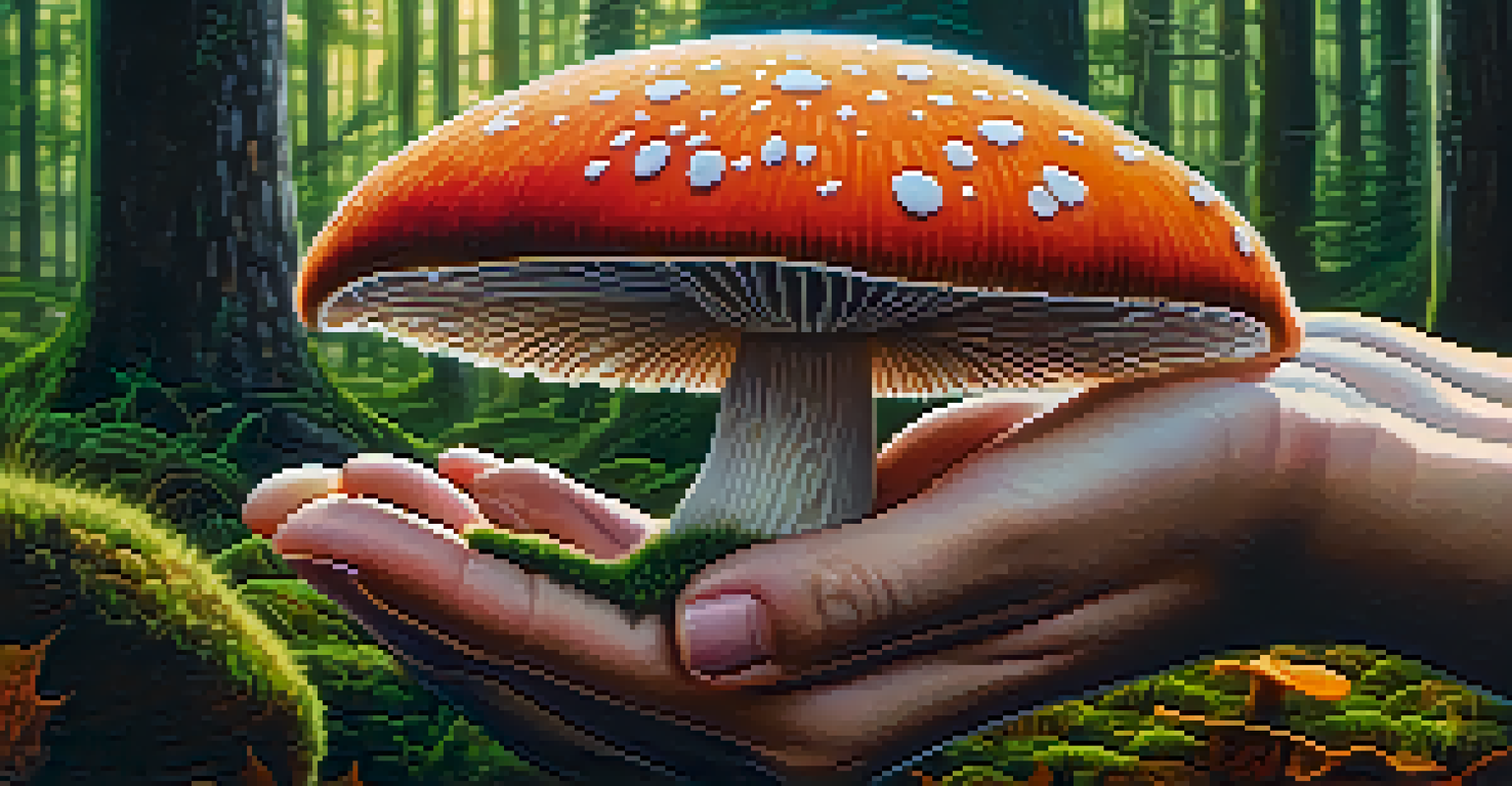The Science Behind Entheogens and Emotional Balance

Understanding Entheogens: What Are They?
Entheogens are substances that are often derived from plants and fungi, used primarily for spiritual or therapeutic purposes. They have been a part of various cultures throughout history, providing a means to explore consciousness and connect with the divine. Common examples include psilocybin mushrooms, ayahuasca, and peyote, each offering unique experiences and benefits.
The mind is everything. What you think you become.
These substances work by interacting with the brain's receptors, particularly serotonin receptors, which play a crucial role in mood regulation and emotional balance. This interaction can lead to altered perceptions and profound insights, often helping individuals process emotions or traumatic experiences. Simply put, entheogens can serve as catalysts for personal growth and healing.
While the use of entheogens is often associated with spiritual journeys, recent scientific studies are focusing on their potential therapeutic applications, especially in treating mental health disorders like PTSD and depression. As more research emerges, we are beginning to understand the complex relationship between entheogens and emotional well-being.
The Role of Neurotransmitters in Emotional Balance
Neurotransmitters are chemical messengers in the brain that communicate between neurons, significantly influencing our mood and emotions. Key players include serotonin, dopamine, and norepinephrine, each playing a vital role in regulating our emotional states. When these neurotransmitters are out of balance, it can lead to conditions like anxiety and depression.

Entheogens, particularly those that affect serotonin levels, can help restore this balance. For instance, psilocybin has been shown to increase serotonin activity, potentially alleviating symptoms of depression and anxiety. This restoration can lead to a more stable emotional state, allowing individuals to cope better with life's challenges.
Entheogens Aid Emotional Healing
Entheogens facilitate profound emotional healing by helping individuals process traumas and gain new perspectives.
Understanding how entheogens interact with these neurotransmitters helps demystify their effects on emotional health. By facilitating a rebalancing of these chemicals, individuals may find themselves more in tune with their emotions and better equipped to handle stressors.
Entheogens and Their Impact on Emotional Healing
Many individuals report transformative experiences during entheogen use, often leading to significant emotional healing. These experiences can provide new perspectives on personal issues and traumas, facilitating a deeper understanding of oneself. This process can be likened to peeling back layers of an onion, revealing core issues that need addressing.
Healing is a matter of time, but it is sometimes also a matter of opportunity.
Research indicates that entheogen-assisted therapy can lead to lasting changes in emotional and psychological states. Patients often express feelings of connectedness, compassion, and clarity, which can help them confront and process past traumas. This emotional release can be cathartic, enabling individuals to move forward with their lives.
Furthermore, the communal aspect of some entheogen experiences can enhance feelings of support and acceptance. Sharing these journeys with others can create powerful bonds, fostering a sense of belonging and emotional safety, which is crucial for healing.
Safety and Risk Factors of Entheogen Use
While entheogens can offer emotional benefits, it is essential to approach their use with caution. Not all experiences are positive; some individuals may encounter challenging or distressing effects, known as 'bad trips.' These experiences can be overwhelming and may exacerbate existing mental health issues if not properly managed.
To mitigate risks, it’s important to consume entheogens in a safe, supportive environment, ideally with a trained facilitator or therapist. This setting can provide guidance and support, helping individuals navigate their experiences and integrate insights gained during the journey. Additionally, understanding one's mental health status before engaging with entheogens is crucial.
Neurotransmitters Influence Mood
Key neurotransmitters like serotonin play a significant role in mood regulation, and entheogens can help restore their balance.
Ultimately, the goal should be to harness the potential benefits of entheogens while minimizing risks. With proper precautions and guidance, individuals can explore the emotional healing they offer, making informed choices about their mental health journey.
The Therapeutic Potential of Entheogens in Modern Medicine
Recent years have seen a resurgence of interest in the therapeutic potential of entheogens within modern medicine. Clinical trials are exploring their effects on various mental health issues, including depression, anxiety, and addiction. This shift reflects a growing recognition that traditional pharmacotherapy may not be effective for everyone.
Studies have shown promising results, indicating that entheogens can facilitate significant improvements in patients’ emotional and psychological well-being. For example, research on psilocybin has demonstrated its ability to reduce symptoms of treatment-resistant depression, offering hope for those who have struggled with conventional treatments.
As research expands, the integration of entheogens into therapeutic settings may reshape how we approach mental health care. By combining traditional therapeutic methods with the unique insights provided by entheogens, practitioners could offer more holistic and effective treatment options for individuals seeking emotional balance.
Cultural Perspectives on Entheogens and Emotions
Different cultures have long embraced entheogens as tools for emotional healing and spiritual connection. Indigenous peoples, for instance, have utilized plants like ayahuasca for centuries in ceremonial contexts, emphasizing the importance of community and tradition in these experiences. These practices often weave together emotional, spiritual, and physical healing.
In contrast, the modern Western perspective has been more skeptical, often viewing entheogens through the lens of legality and safety rather than their potential benefits. However, as scientific research sheds light on their therapeutic applications, many are beginning to reconsider their place in emotional health practices.
Cultural Views Shape Usage
Different cultural perspectives on entheogens highlight their historical significance and evolving acceptance in modern therapeutic practices.
Understanding these cultural perspectives enriches our appreciation of entheogens and their role in human experience. By learning from both traditional and contemporary approaches, we can create a more inclusive dialogue about emotional healing and the tools available to us.
Integrating Entheogens into Personal Growth Practices
For those interested in exploring emotional balance through entheogens, integrating them into a broader personal growth practice can be beneficial. This might include mindfulness techniques, journaling, or therapy sessions that focus on preparing for and integrating experiences. These practices can help individuals process insights gained during entheogen use and apply them to their everyday lives.
Creating a supportive environment, whether through community or personal practice, enhances the potential benefits of entheogens. Engaging with others who share similar interests can foster a sense of belonging and encouragement, which is essential for emotional growth. Sharing experiences and insights can also deepen understanding and integration.

Ultimately, the journey with entheogens should be seen as a part of a larger quest for emotional balance and self-discovery. By combining these experiences with ongoing personal growth practices, individuals can cultivate a more profound connection with themselves and their emotions.